[English] 日本語
 Yorodumi
Yorodumi- PDB-7yca: Cryo-EM structure of the PSI-LHCI-Lhcp supercomplex from Ostreoco... -
+ Open data
Open data
- Basic information
Basic information
| Entry | Database: PDB / ID: 7yca | |||||||||||||||
|---|---|---|---|---|---|---|---|---|---|---|---|---|---|---|---|---|
| Title | Cryo-EM structure of the PSI-LHCI-Lhcp supercomplex from Ostreococcus tauri | |||||||||||||||
 Components Components |
| |||||||||||||||
 Keywords Keywords | PHOTOSYNTHESIS / Complex / Electron transport | |||||||||||||||
| Function / homology |  Function and homology information Function and homology informationchloroplast photosystem I / photosynthesis, light harvesting / chloroplast thylakoid lumen / photosystem I reaction center / photosystem I / photosynthetic electron transport in photosystem I / photosystem I / photosystem II / chlorophyll binding / chloroplast thylakoid membrane ...chloroplast photosystem I / photosynthesis, light harvesting / chloroplast thylakoid lumen / photosystem I reaction center / photosystem I / photosynthetic electron transport in photosystem I / photosystem I / photosystem II / chlorophyll binding / chloroplast thylakoid membrane / photosynthesis / chloroplast / 4 iron, 4 sulfur cluster binding / oxidoreductase activity / electron transfer activity / magnesium ion binding / metal ion binding / membrane Similarity search - Function | |||||||||||||||
| Biological species |  Ostreococcus tauri (plant) Ostreococcus tauri (plant) | |||||||||||||||
| Method | ELECTRON MICROSCOPY / single particle reconstruction / cryo EM / Resolution: 2.94 Å | |||||||||||||||
 Authors Authors | Shan, J. / Sheng, X. / Ishii, A. / Watanabe, A. / Song, C. / Murata, K. / Minagawa, J. / Liu, Z. | |||||||||||||||
| Funding support |  Japan, Japan,  China, 4items China, 4items
| |||||||||||||||
 Citation Citation |  Journal: Elife / Year: 2023 Journal: Elife / Year: 2023Title: The photosystem I supercomplex from a primordial green alga harbors three light-harvesting complex trimers. Authors: Asako Ishii / Jianyu Shan / Xin Sheng / Eunchul Kim / Akimasa Watanabe / Makio Yokono / Chiyo Noda / Chihong Song / Kazuyoshi Murata / Zhenfeng Liu / Jun Minagawa /   Abstract: As a ubiquitous picophytoplankton in the ocean and an early-branching green alga, is a model prasinophyte species for studying the functional evolution of the light-harvesting systems in ...As a ubiquitous picophytoplankton in the ocean and an early-branching green alga, is a model prasinophyte species for studying the functional evolution of the light-harvesting systems in photosynthesis. Here, we report the structure and function of the photosystem I (PSI) supercomplex in low light conditions, where it expands its photon-absorbing capacity by assembling with the light-harvesting complexes I (LHCI) and a prasinophyte-specific light-harvesting complex (Lhcp). The architecture of the supercomplex exhibits hybrid features of the plant-type and the green algal-type PSI supercomplexes, consisting of a PSI core, an Lhca1-Lhca4-Lhca2-Lhca3 belt attached on one side and an Lhca5-Lhca6 heterodimer associated on the other side between PsaG and PsaH. Interestingly, nine Lhcp subunits, including one Lhcp1 monomer with a phosphorylated amino-terminal threonine and eight Lhcp2 monomers, oligomerize into three trimers and associate with PSI on the third side between Lhca6 and PsaK. The Lhcp1 phosphorylation and the light-harvesting capacity of PSI were subjected to reversible photoacclimation, suggesting that the formation of PSI-LHCI-Lhcp supercomplex is likely due to a phosphorylation-dependent mechanism induced by changes in light intensity. Notably, this supercomplex did not exhibit far-red peaks in the 77 K fluorescence spectra, which is possibly due to the weak coupling of the chlorophyll 603-609 pair in Lhca1-4. | |||||||||||||||
| History |
|
- Structure visualization
Structure visualization
| Structure viewer | Molecule:  Molmil Molmil Jmol/JSmol Jmol/JSmol |
|---|
- Downloads & links
Downloads & links
- Download
Download
| PDBx/mmCIF format |  7yca.cif.gz 7yca.cif.gz | 1.6 MB | Display |  PDBx/mmCIF format PDBx/mmCIF format |
|---|---|---|---|---|
| PDB format |  pdb7yca.ent.gz pdb7yca.ent.gz | 1.4 MB | Display |  PDB format PDB format |
| PDBx/mmJSON format |  7yca.json.gz 7yca.json.gz | Tree view |  PDBx/mmJSON format PDBx/mmJSON format | |
| Others |  Other downloads Other downloads |
-Validation report
| Summary document |  7yca_validation.pdf.gz 7yca_validation.pdf.gz | 24.7 MB | Display |  wwPDB validaton report wwPDB validaton report |
|---|---|---|---|---|
| Full document |  7yca_full_validation.pdf.gz 7yca_full_validation.pdf.gz | 25.9 MB | Display | |
| Data in XML |  7yca_validation.xml.gz 7yca_validation.xml.gz | 347.2 KB | Display | |
| Data in CIF |  7yca_validation.cif.gz 7yca_validation.cif.gz | 411.4 KB | Display | |
| Arichive directory |  https://data.pdbj.org/pub/pdb/validation_reports/yc/7yca https://data.pdbj.org/pub/pdb/validation_reports/yc/7yca ftp://data.pdbj.org/pub/pdb/validation_reports/yc/7yca ftp://data.pdbj.org/pub/pdb/validation_reports/yc/7yca | HTTPS FTP |
-Related structure data
| Related structure data |  33737MC 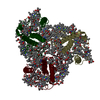 8hg3C 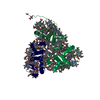 8hg5C 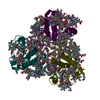 8hg6C M: map data used to model this data C: citing same article ( |
|---|---|
| Similar structure data | Similarity search - Function & homology  F&H Search F&H Search |
- Links
Links
- Assembly
Assembly
| Deposited unit | 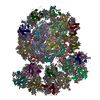
|
|---|---|
| 1 |
|
- Components
Components
-Protein , 5 types, 5 molecules 16GLO
| #1: Protein | Mass: 24128.406 Da / Num. of mol.: 1 / Source method: isolated from a natural source / Source: (natural)  Ostreococcus tauri (plant) / References: UniProt: Q3B9U3 Ostreococcus tauri (plant) / References: UniProt: Q3B9U3 |
|---|---|
| #6: Protein | Mass: 26742.605 Da / Num. of mol.: 1 / Source method: isolated from a natural source / Source: (natural)  Ostreococcus tauri (plant) / References: UniProt: A0A1Y5IA87 Ostreococcus tauri (plant) / References: UniProt: A0A1Y5IA87 |
| #13: Protein | Mass: 14124.991 Da / Num. of mol.: 1 / Source method: isolated from a natural source / Source: (natural)  Ostreococcus tauri (plant) / References: UniProt: Q019T9 Ostreococcus tauri (plant) / References: UniProt: Q019T9 |
| #18: Protein | Mass: 21526.773 Da / Num. of mol.: 1 / Source method: isolated from a natural source / Source: (natural)  Ostreococcus tauri (plant) / References: UniProt: A0A090M7B0 Ostreococcus tauri (plant) / References: UniProt: A0A090M7B0 |
| #21: Protein | Mass: 15020.308 Da / Num. of mol.: 1 / Source method: isolated from a natural source / Source: (natural)  Ostreococcus tauri (plant) / References: UniProt: A0A096P9N0 Ostreococcus tauri (plant) / References: UniProt: A0A096P9N0 |
-Chlorophyll a-b binding protein, ... , 6 types, 13 molecules 2345PRSTUVWXQ
| #2: Protein | Mass: 26404.020 Da / Num. of mol.: 1 / Source method: isolated from a natural source / Source: (natural)  Ostreococcus tauri (plant) / References: UniProt: A0A454XUD2 Ostreococcus tauri (plant) / References: UniProt: A0A454XUD2 | ||
|---|---|---|---|
| #3: Protein | Mass: 29432.744 Da / Num. of mol.: 1 / Source method: isolated from a natural source / Source: (natural)  Ostreococcus tauri (plant) / References: UniProt: Q3B9U5 Ostreococcus tauri (plant) / References: UniProt: Q3B9U5 | ||
| #4: Protein | Mass: 25924.592 Da / Num. of mol.: 1 / Source method: isolated from a natural source / Source: (natural)  Ostreococcus tauri (plant) / References: UniProt: Q3B9V1 Ostreococcus tauri (plant) / References: UniProt: Q3B9V1 | ||
| #5: Protein | Mass: 23401.027 Da / Num. of mol.: 1 / Source method: isolated from a natural source / Source: (natural)  Ostreococcus tauri (plant) / References: UniProt: A0A090M1L8 Ostreococcus tauri (plant) / References: UniProt: A0A090M1L8 | ||
| #22: Protein | Mass: 24689.807 Da / Num. of mol.: 8 / Source method: isolated from a natural source / Source: (natural)  Ostreococcus tauri (plant) / References: UniProt: Q3B9U7 Ostreococcus tauri (plant) / References: UniProt: Q3B9U7#23: Protein | | Mass: 24161.299 Da / Num. of mol.: 1 / Source method: isolated from a natural source / Source: (natural)  Ostreococcus tauri (plant) / References: UniProt: A0A090LYE8 Ostreococcus tauri (plant) / References: UniProt: A0A090LYE8 |
-Photosystem I ... , 12 types, 12 molecules ABCDEFHIJKMN
| #7: Protein | Mass: 83249.305 Da / Num. of mol.: 1 / Source method: isolated from a natural source / Source: (natural)  Ostreococcus tauri (plant) / References: UniProt: Q0P3K1, photosystem I Ostreococcus tauri (plant) / References: UniProt: Q0P3K1, photosystem I |
|---|---|
| #8: Protein | Mass: 81421.508 Da / Num. of mol.: 1 / Source method: isolated from a natural source / Source: (natural)  Ostreococcus tauri (plant) / References: UniProt: Q0P3K2, photosystem I Ostreococcus tauri (plant) / References: UniProt: Q0P3K2, photosystem I |
| #9: Protein | Mass: 8751.128 Da / Num. of mol.: 1 / Source method: isolated from a natural source / Source: (natural)  Ostreococcus tauri (plant) / References: UniProt: Q0P3P1, photosystem I Ostreococcus tauri (plant) / References: UniProt: Q0P3P1, photosystem I |
| #10: Protein | Mass: 20560.975 Da / Num. of mol.: 1 / Source method: isolated from a natural source / Source: (natural)  Ostreococcus tauri (plant) / References: UniProt: A0A1Y5I5Y8 Ostreococcus tauri (plant) / References: UniProt: A0A1Y5I5Y8 |
| #11: Protein | Mass: 11278.889 Da / Num. of mol.: 1 / Source method: isolated from a natural source / Source: (natural)  Ostreococcus tauri (plant) / References: UniProt: A0A454XT75 Ostreococcus tauri (plant) / References: UniProt: A0A454XT75 |
| #12: Protein | Mass: 24593.398 Da / Num. of mol.: 1 / Source method: isolated from a natural source / Source: (natural)  Ostreococcus tauri (plant) / References: UniProt: Q01B61 Ostreococcus tauri (plant) / References: UniProt: Q01B61 |
| #14: Protein | Mass: 17797.947 Da / Num. of mol.: 1 / Source method: isolated from a natural source / Source: (natural)  Ostreococcus tauri (plant) / References: UniProt: A0A096PAU9 Ostreococcus tauri (plant) / References: UniProt: A0A096PAU9 |
| #15: Protein/peptide | Mass: 3766.573 Da / Num. of mol.: 1 / Source method: isolated from a natural source / Source: (natural)  Ostreococcus tauri (plant) / References: UniProt: Q0P3K0 Ostreococcus tauri (plant) / References: UniProt: Q0P3K0 |
| #16: Protein/peptide | Mass: 4731.595 Da / Num. of mol.: 1 / Source method: isolated from a natural source / Source: (natural)  Ostreococcus tauri (plant) / References: UniProt: Q0P3J4 Ostreococcus tauri (plant) / References: UniProt: Q0P3J4 |
| #17: Protein | Mass: 13573.483 Da / Num. of mol.: 1 / Source method: isolated from a natural source / Source: (natural)  Ostreococcus tauri (plant) / References: UniProt: A0A096P8E8 Ostreococcus tauri (plant) / References: UniProt: A0A096P8E8 |
| #19: Protein/peptide | Mass: 3413.078 Da / Num. of mol.: 1 / Source method: isolated from a natural source / Source: (natural)  Ostreococcus tauri (plant) / References: UniProt: Q0P3J8 Ostreococcus tauri (plant) / References: UniProt: Q0P3J8 |
| #20: Protein | Mass: 14405.324 Da / Num. of mol.: 1 / Source method: isolated from a natural source / Source: (natural)  Ostreococcus tauri (plant) / References: UniProt: A0A090N3J0 Ostreococcus tauri (plant) / References: UniProt: A0A090N3J0 |
-Sugars , 1 types, 2 molecules 
| #36: Sugar |
|---|
-Non-polymers , 15 types, 451 molecules 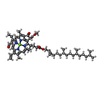

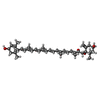
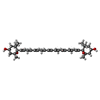

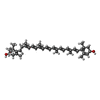



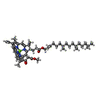
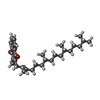

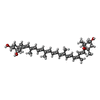
















| #24: Chemical | ChemComp-CHL / #25: Chemical | ChemComp-CLA / #26: Chemical | ChemComp-IWJ / ( #27: Chemical | ChemComp-XAT / ( #28: Chemical | ChemComp-LHG / #29: Chemical | ChemComp-Q6L / ( #30: Chemical | ChemComp-BCR / #31: Chemical | ChemComp-LMG / #32: Chemical | #33: Chemical | ChemComp-CL0 / | #34: Chemical | #35: Chemical | #37: Chemical | ChemComp-NEX / ( |
|---|
 Movie
Movie Controller
Controller





 PDBj
PDBj





















